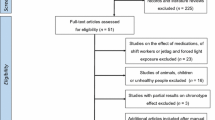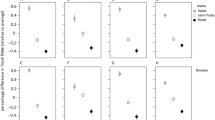Abstract
Purpose of Review
This review discusses the opportunities and challenges of training and competing “around the clock.”
Recent Findings
This review focuses on three key areas of study to include: (1) diurnal variation in biologically-driven (circadian-dependent) energy utilization required for aerobic and anaerobic endurance; (2) chronotype and its relationship to athletic performance; and (3) leveraging circadian-driven processes to win “around the clock” and the use of fatigue countermeasures when game time does not align with predicted peaks in athletic performance.
Summary
Thus, a full-scope understanding of circadian-driven substrates and mechanisms can help to optimize performance. All the research presented is thematically based on case studies and actual performance-related issues from professional athletes (quoted throughout the text).

Similar content being viewed by others
References
Papers of particular interest, published recently, have been highlighted as: • Of importance •• Of major importance
Watson AM. Sleep and athletic performance. Curr Sports Med Rep. 2017;16(6):413–8.
Consensus Conference Panel, Watson NF, Badr MS, Belenky G, Bliwise DL, Buxton OM, Buysse D, Dinges DF, Gangswich J, Grander M, Kushida C, Malhotra R, Martin J, Patel S, Quan S, Tasali E. Recommended amount of sleep for a healthy adult: a joint consensus statement of the American Academy of Sleep Medicine and Sleep Research Society. J Clin Sleep Med. 2015;11(6):591–2.
Vlahoyiannis A, Aphamis G, Bogdanis GC, Sakkas GK, Andreou E, Giannaki CD (2020). Deconstructing athletes’ sleep: a systematic review of the influence of age, sex, athletic expertise, sport type, and season on sleep characteristics. J Sport and Health Sci. Considerations of age, sex, experience, and sport type (aerobic and anaerobic) for determining the overall impact on sleep health, performance, and risk factors for sleep disorders.
Roberts SSH, Teo WP, Warmington SA. Effects of training and competition on the sleep of elite athletes: a systematic review and meta-analysis. Br J Sports Med. 2019;53(8):513–22.
Roane B, Van Reen E, Hart C, Wing R, Carskadon M. Estimating sleep from multisensory armband measurements: validity and reliability in teens. J Sleep Res. 2015;24(6):714–21.
Trinder J, Paxton SJ, Montgomery J, Fraser G. Endurance as opposed to power training: their effect on sleep. Psychophysiology. 1985;22(6):668–73.
Thun E, Bjorvatn B, Flo E, Harris A, Pallesen S. Sleep, circadian rhythms, and athletic performance. Sleep Med Rev. 2015;23:1–9.
Omiya K, Akashi YJ, Yoneyama K, Osada N, Tanabe K, Miyake F. Heart-rate response to sympathetic nervous stimulation, exercise, and magnesium concentration in various sleep conditions. Int J Sport Nutr Exerc Metab. 2009;19(2):127–35.
Trivedi MS, Holger D, Bui AT, Craddock TJ, Tartar JL. Short-term sleep deprivation leads to decreased systemic redox metabolites and altered epigenetic status. PLoS ONE. 2017;12(7):e0181978.
Rao MN, Neylan TC, Grunfeld C, Mulligan K, Schambelan M, Schwarz JM. Subchronic sleep restriction causes tissue-specific insulin resistance. J Clin Endocrinol Metab. 2015;100(4):1664–71.
Lamia KA, Storch KF, Weitz CJ. Physiological significance of a peripheral tissue circadian clock. Proc Natl Acad Sci. 2008;105(39):15172–7.
Lee A, Galvez JC. Jet lag in athletes. Sports. Health. 2012;4(3):211–6.
Lemmer B, Kern RI, Nold G, Lohrer H. Jet lag in athletes after eastward and westward time-zone transition. Chronobiol Int. 2002;19(4):743–64.
Waterhouse JA, Edwards B, Nevill A, Carvalho S, Atkinson G, Buckley P, Reilly T, Godfrey R, Ramsay R. Identifying some determinants of “jet lag” and its symptoms: a study of athletes and other travellers. Br J Sports Med. 2002;36(1):54–60.
Yamanaka Y, Hashimoto S, Takasu NN, Tanahashi Y, Nishide SY, Honma S, Honma KI. Morning and evening physical exercise differentially regulate the autonomic nervous system during nocturnal sleep in humans. Am J Physiol-Reg Integrative Comparative Physiol. 2015;309(9):R1112–2112.
Facer-Childs E, Brandstetter R. The impact of circadian phenotype and time since awakening on diurnal performance in athletes. Curr Biol. 2015;25(4):518–22.
Scheer F, Hu K, Evoniuk H, Kelly E, Malhotra A, Hilton M, et al. Impact of the human circadian system, exercise, and their interaction on cardiovascular function. Proc Natl Acad Sci. 2010;107(47):20541–6.
Czeisler C, Duffy J, Shanahan T, Brown E, Mitchell J, Rimmer D, et al. Stability, precision, and near 24-h period of the human circadian pacemaker. Science. 1999;284(5423):2177–81.
Brager A, Demiral S, Choynowski J, Kim J, Campbell B, Capaldi V, et al. Earlier shift in race pacing can predict future performance during a single-effort ultramarathon under sleep deprivation. Sleep Sci. 2020;13(1):25–31.
Kline C, Durstine J, Davis J, Moore T, Devlin T, Zielinski M, et al. Circadian variation in swim performance. J App Physiol. 2007;102(2):641–9.
Martin L, Nevill A, Thompson K. Diurnal variation in swim performance remains irrespective of training once or twice daily. Int J Sports Physiol Perf. 2007;2(2):192–200.
Brager AJ, Mistovich RJ. Game times and high winning percentages of west coast teams of the National Football League correspond with reduced prevalence of regular season injury. J Strength Cond Res. 2017;31(2):462–7 Real-world ecological example from professional sports as to how circadian-driven physiological processes can positively and negatively influence athletic performance and competition outcomes.
Hammouda O, Chtourou H, Chaouachi A, Chahed H, Bellimem H, Chamari K, et al. Time-of-day effects on biochemical responses to soccer-specific endurance in elite Tunisian football players. J Sports Sci. 2013;31(9):1–10.
Blumert P, Crum A, Ernstng M, Volek J, Hollander D, Haff E, et al. The acute effects of twenty-four hours of sleep loss on the performance of national caliber male collegiate weightlifters. J Strength Cond. 2007;21(4):1146–54.
Mora-Rodriguez R, Pallares J, Lopez-Gullon J, Lopez-Samanes A, Fernandez-Elias V, Ortega J. Improvements on neuromuscular performance with caffeine ingestion depend on the time-of-day. J Sci Med Sport. 2015;18(3):338–42 One of few clinical trials conducted in athletes to examine the neurobiological substrates and effective countermeasures that can influence circadian-driven performance advantages and disadvantages.
Souissi N, Gauthier A, Sesboue B, Larue J, Davenne D. Circadian rhythms in two types of anaerobic cycle leg exercise: force velocity and 30 s wingate tests. Physiol Behav. 2004;25(1):14–9.
Pallares J, Lopez-Samanes A, Moreno J, Fernandez-Elias V, Fernando Ortega J, More-Rodriguez R. Circadian rhythm effects on neuromuscular and sprint swimming performance. J Biol Rhy. 2014;45(1):1–12.
M Diego, A Lopez-Samanes, J Munoz, J Pallares, R Mora-Rodriguez, Circadian rhythm effect on neuromuscular performance in trained male players. J Sports Sci (2016) 1466 - 1477.
Bullock N, Martin D, Ross A, Rosemond D, Marino F. Effect of long haul travel on maximal sprint performance and diurnal variations in elite skeleton athletes. Brit J Sports Med. 2007;41(9):573–573.
Youngstedt S, Kline C, Elliott J, Zielinski M, Devlin T, Moore T. Circadian phase-shifting effects of bright light, exercise, and bright light + exercise. J Circadian Rhythms. 2016;14(2):1–6.
Youngstedt S, Elliott J, Kripke D. Human circadian phase-response curves for exercise. J Physiol. 2019;597(8):2253–68.
Stothard ER, et al. Circadian entrainment to the natural light-dark cycle across seasons and the weekend. Curr Biol. 2017;27:508–13.
Lockley S. Safety considerations for the use of blue-light blocking glasses in shift-workers. J Pineal Res. 2007;42(2):210–1.
A. Brager, G. Simonelli, Current state of sleep-related performance optimization interventions for the E-sports industry, J. Neurosports 1 (1) 1 -4.
Caldelas I, Poirel V, Sicard B, Pvet P, Challet E. Circadian profile and photic regulation of clock genes in the suprachiasmatic nucleus of a diurnal mammal arvicanthis ansorgei. Neuroscience. 2003;116(2):583–91.
Coomans C, van den Berg S, Houben T, Klinken J, van den Berg R, Pronk A. Detrimental effects of constant light exposure and high-fat diet on circadian energy metabolism and insulin sensitivity. FASEB J. 2013;27(4):1721–32.
Mizutani H, Tamagawa-Mineoka R, Minami Y, Yagita K, Katoh N. Constant light exposure impairs immune tolerance development in mice. J Dermatological Sci. 2017;86(1):63–70.
Author information
Authors and Affiliations
Corresponding author
Ethics declarations
Ethics Approval
The opinions or assertions contained herein are the private views of the author, and are not to be construed as official, or as reflecting true views of the Department of the Army or the Department of Defense. No human or animal research was conducted to support views of the authors.
Conflict of Interest
VM has served as a consultant for Armed Forces HST, CPAP medical, Jazz Pharmaceuticals, Mindstrong, NOCTEM Health and SleepCare Inc. AB has served as a consultant for WHOOP, Inc., FitAid, Inc., Momentous, Inc., and the National Academy of Sports Medicine.
Human and Animal Rights and Informed Consent
This article does not contain any studies with human or animal subjects performed by any of the authors.
Additional information
Publisher's Note
Springer Nature remains neutral with regard to jurisdictional claims in published maps and institutional affiliations.
Topical Collection on Sleep and Athletic Performance
Rights and permissions
About this article
Cite this article
Brager, A.J., Gordon, J.A., Rouska, A. et al. Circadian Advantages in Elite Athletes. Curr Sleep Medicine Rep 8, 187–192 (2022). https://doi.org/10.1007/s40675-022-00239-0
Accepted:
Published:
Issue Date:
DOI: https://doi.org/10.1007/s40675-022-00239-0




